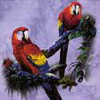Please Help Pets by Donating One Dollar
Proventricular Dilatation Syndrome, Neuropathic
Gastric Dilatation or Macaw Wasting Disease
by Linda Pesek, DVM
Proventricular Dilatation Syndrome, Neuropathic Gastric
Dilatation or Macaw Wasting Disease, is a very devastating, fatal
disease affecting not only macaws, but many other species as
well. This disease was first recognized in 1971 and since then
has been seen in many species including toos, conures, grey
parrots, tiels, Eclectus parrots, thick billed Amazons, Blue
fronted Amazons, and budgies, as well as macaws. These birds have
been as young as 10 weeks of age and as old as 17 years.
This disease is thought to be caused by a virus. Birds often
present with a history of regurgitation, chronic bacterial or
fungal crop infections, pendulous crops, history of weight loss,
passage of whole intact seeds in droppings, in-coordination, or
sudden death. These signs, unfortunately, are not specific for
this disease. Other conditions such as lead poisoning, bacterial
and fungal infections, foreign bodies and obstructions can mimic
this disease.
Antemortem diagnosis of Proventricular Dilatation can be
difficult. Suspicion of this disease is based upon history and
physical examination. A complete workup should be performed which
includes a CBC, blood chemistry, bacterial and fungal cultures
and sensitivities, and a chlamydia test. Survey and contrast
X-rays may demonstrate a dilated proventriculus (glandular
stomach) and delayed passage of barium from the gastrointestinal
tract. These findings further support a tentative diagnosis but
are not conclusive. A definitive diagnosis is based upon a biopsy
of the crop, ventriculous (gizzard) or proventriculous,
demonstrating characteristic histopathologic changes. The
characteristic lesions may not be uniformly distributed
throughout the affected organ, so multiple biopsies are
necessary.
Proventricular Dilatation Syndrome is a very difficult disease
because its transmission, incubation and latency are unknown.
Once it occurs in an aviary, it is difficult, if not impossible,
to irradicate.
No effective treatment is known. Supportive care may help prolong
the lives of affected birds. It is considered to be a fatal
disease.
Picture Macaws
